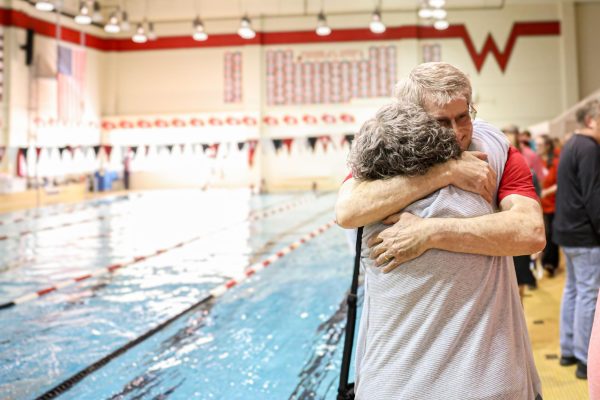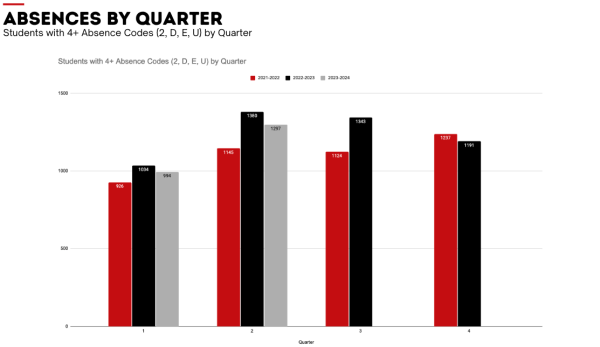Heavy Backpacks…Heavy Consequences?

Senior Sarah Snyder is 5’3” and slim and athletic, but her backpack would be a burden for a much larger person.
It contains her 4.7-pound laptop, four notebooks, and a few folders full of papers for the nine classes she’s taking. The outer pockets are full of money, keys, snacks and a graphing calculator.
“Walking to class, it’s fine, but if I have to walk around the school and run errands or something, it gets really heavy and it starts to put a strain on my upper back,” Snyder said.
Snyder isn’t alone in feeling the effects of her heavy backpack; a recent study conducted in Italy found that 79.1% of 11-year-olds found their backpacks too heavy, and 46.1% complained of back pain.
There haven’t been any major studies on backpack weight conducted in the United States yet, but California has already passed a law that would make school districts find ways to lighten students’ loads, and New Jersey is considering one.
Here in Omaha, Dr. Jeffrey Clark, a local chiropractor, said it’s clear many students are carrying a load they shouldn’t be carrying all day.
“I have students who come in all the time and they know the reason they have problems is the heavy backpack,” Clark said.
Clark, who treats some Westside students, compared carrying a 25-pound backpack to “carrying a cinderblock on your back.” He said although a backpack shouldn’t weigh more than five to 10 percent of a person’s body weight, the most important thing in protecting your back is carrying the backpack correctly.
“You’re better off putting both your arms in the backpack straps, and making sure it’s high up on your back,” he said.
According to the American Chiropractic Association (ACA), carrying a backpack with the weight shifted to one side can cause neck and muscle spasms and lower back pain.
“I carry it with two [straps] because freshman year for like a week, I carried it with one strap and my back hurt really bad,” Snyder said. “I started using two.”
In addition, many students carry their backpacks with the straps loose, which makes the backpack hang down. The ACA recommends that students use adjustable straps and have their backpacks hanging no more than four inches below the waist; if the bag is any lower, it makes the back bend forward. Clark said a dangling backpack can cause misalignment of the vertebrae.
“My backpack’s kind of in the middle,” Snyder said. “It’s not super low so as to put a bunch of strain on my back, but it’s not where it’s supposed to be.”
Carrying a backpack that is too heavy or carried incorrectly can lead to all sorts of pain, according to Clark. He said backpack misuse can cause neck pain, back pain, leg pain, and arm pain; over time, it can contribute to causing a scoliosis, or curvature of the spine.
According to an article on the ACA website, “The longer a child wears a backpack, the longer it takes for a curvature or deformity of the spine to correct itself” — if it ever corrects itself.
Perhaps the most dangerous thing about heavy backpacks, though, is the fact that associated problems may not show up until years later. Although Clark said some teenagers may experience back pain now, it will probably be worse later in life.
“Eighty percent of all lower back problems or disc problems occur before the age of 16, but you may not know it if you’re 35 or 40,” Clark said. “It doesn’t hurt because you guys are young and flexible, but later in life, you’re like, ‘Man, my back’s killing me, what did I do?’ And it might be something you did 20 years ago.”
Clark recommended carrying some textbooks outside the backpack, and going back and forth to a locker during the day if possible. However, as students try to get to different parts of the school in five minutes during the day, visiting a locker may not always seem practical.
“I have a locker, but I don’t really use it to go to in the middle of the day,” Snyder said.
Snyder said she often carries one or two textbooks in her arms because she doesn’t think they’ll fit in her backpack. It depends on when she’s planning to get things done.
In the fall, after being told she had an emerging stress fracture in her lower back from running, Snyder tried not to carry her backpack as much, but she said she didn’t do much to reduce its weight. Although science is clear on the fact that students should carry lighter backpacks, sometimes that’s easier said than done.
“I think all the stuff that I have is stuff that is good to have, and stuff that I might forget to put back in my backpack if I took it out,” Snyder said. “But some of my classes I only have once or twice a week, so I don’t need some of the stuff sometimes, I guess.”
Your donation will support the student journalists of Omaha Westside High School. Your contribution will allow us to purchase equipment and cover our annual website hosting costs.











